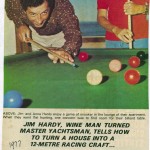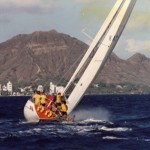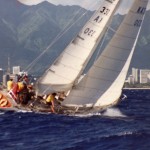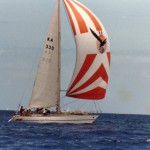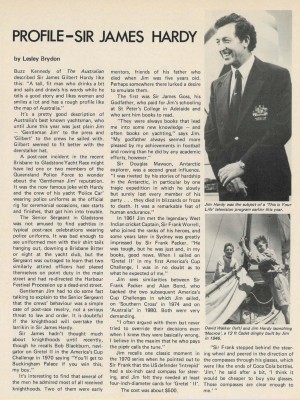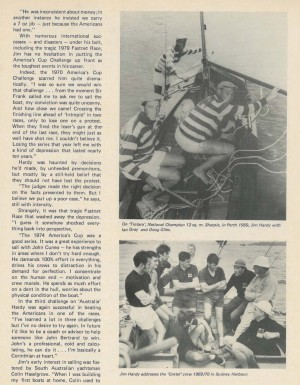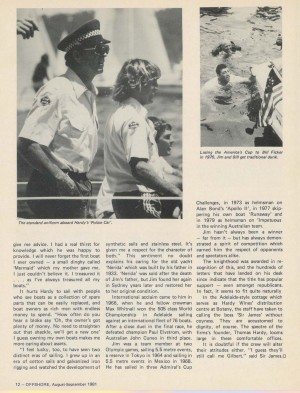| James Hardy | |
|---|---|
| Other Name | Jim Hardy, Sir James Hardy |
| Gender | Male |
| Nationality | Australian |
| Hometown | Sydney |
James Hardy
Pictures & Articles | 1977Jim Hardy, Wine man turned master yachtsman, tells how to turn a house into a 12-metre raceing craft... By Dulcie Boling in Sydney"I'm converting my house into a 12 metre yacht." From anyone else, it would be a facetious comment - from Australia's best known yachtsman, Jim Hardy, it is, quite simply, a statement of fact. The skipper of the last two Australian challenges for the America's Cup, and one of the world's most experienced international 12 metre class yachtsmen, had planned a third onslaught on the Americans in '77 with his "people's boat" financed by the Australian public, but his Matilda Syndicate foundered last Easter for lack of financial support. That was the beginning of his plan to "go it alone" in another direction, sell off his assets, and build his own all-Australian yacht, hopefully, to compete in the great British ocean racing event, The Admiral's Cup, off Cowes, in July-August this year. His family home for the past 14 years, in a Sydney north shore suburb, was the first to go. That went on the market in November, a few weeks after construction began on the "dream boat'. He and his wife, Anne, and their two sons moved into an apartment a few km away. The expensive Daimler car was sold off in December, and replaced with an older model Jaguar. As Jim Hardy explained: "A boat like this will cost up to $100,000. I'll be carrying the whole thing. "I have equity in our family wine company which is owned by a fairly broad base - I'm one of about 16 in it. It earns a bit of income, not all that much, but I'm locked into it, and I don't wish to sell out my interest in the company, so I had to look around at what -other assets I've got that are not earning income." That left his house and his car. Anne Hardy was taking the conversion of her home into a 12 metre yacht very calmly. "I think it's great," she said, "The house was too big for us anyway. 'I'he apartment is lovely, it overlooks the ocean, and I'm very happy there. "I must admit I was a bit dubious about moving into an apartment, but I love it." No, she smiled, Jim hadn't discussed selling the house with her, he'd just come home one day and said they were selling out. "I didn't have time to think about it," she laughed. "We had talked at some length about trying to raise the money to buy this boat, hadn't we?" Jim interjected. Anne laughed: "The house wasn't mentioned at that stage! " The trials for the Admiral's Cup will be held off Sydney in March. Three boats will be selected to compete from around 10 competitors. If Jim is successful in making the three yacht team, Anne will accompany him to England for the race. "I'll be going over and barracking - that's part of the deal," she said. RIGHT: Jim inspects detailed plans of the new boat. They sold their home and car to finance the bid for world race honours. |
1978 |
|
| James Hardy's Nyamba (KA330) 1978 Pan Am Clipper CupThe 1978 Pan Am Clipper Cup was held in Hawaii |
1981 | PROFILE: SIR JAMES HARDY - CYCA Offshore Magazine - 1981 Aug/SeptNo.61-OFFSHORE-August-September-1981-low-res.pdf (cyca.com.au) Buzz Kennedy of The Australian described Sir James Gilbert Hardy like this: "A tall, fit man who drinks a bit and sails and drawls his words while he tells a good story and likes women and smiles a lot and has a rough profile like the map of Australia." It's a pretty good description of Australia's best-known yachtsman, who until June this year was just plain Jim 'Gentleman Jim' to the press and 'Gilbert' to the crews he sailed with. Gilbert seemed to fit better with the deerstalker hat. A post-race incident in the recent Brisbane to Gladstone Yacht Race might have led one or two members of the Queensland Police Force to wonder about the 'Gentleman Jim' reputation. It was the now famous joke with Hardy and the crew of his yacht Police Car' wearing police uniforms as the official rig for ceremonial occasions, race starts and finishes, that got him into trouble, The Senior Sergeant in Gladstone was not amused to find yachties in typical post-race celebrations wearing police uniforms, It was bad enough to see uniformed men with their shirt tails hanging out, downing a Brisbane Bitter or eight at the yacht club, but the Sergeant was outraged to learn that two similarly attired officers had placed themselves on point duty in the main street and had re-directed the Harbour Festival Procession up a dead-end street. Gentleman Jim had to do some fast talking to explain to the Senior Sergeant that the crews' behaviour was a simple case of post-race revelry, not a serious threat to law and order. It is doubtful if the knighthood will overtake the larrikin in Sir James Hardy. Sir James hadn't thought much about knighthoods until recently, though he recalls Bob Blackburn, naviÂgator on Gretel II in the America's Cup Challenge in 1970 saying "You'll get to Buckingham Palace if you win this, my boy." It's interesting to find that several of the men he admired most of all received knighthoods. Two of them were early mentors, friends of his father who died when Jim was five years old. Perhaps somewhere there lurked a desire to emulate them. The first was Sir James Goss, his Godfather, who paid for Jim's schooling at St Peter's College in Adelaide and who sent him books to read, "They were always books that lead me into some new knowledge - and often books on yachting," says Jim. "My godfather always seemed more pleased by my achievements in football and rowing than he did by any academic efforts, however." Sir Douglas Mawson, Antarctic explorer, was a second great influence. "I was riveted by his stories of hardship in the Antarctic, in particular by one tragic expedition in which he slowly but surely lost every member of his party - they died in blizzards or froze to death. It was a remarkable feat of human endurance." In 1961 Jim met the legendary West Indian cricket Captain, Sir Frank Worrell, who joined the ranks of his heroes, and some years later in Sydney was greatly impressed by Sir Frank Packer, "He was tough, but he was just and, in my books, good news. When l sailed on Gretel in my first America's Cup Challenge, I was in no doubt as to what he expected of me." Jim sees similarities between Sir Frank Packer and Alan Bond, who backed the two subsequent America's Cup Challenges in which Jim sailed, on 'Southern Cross' in 1974 and on 'Australia' in 1980. Both were very demanding. "I often argued with them but never tried to override their decisions even when I knew they were basically wrong. I believe in the maxim that he who pays the piper calls the tune." Jim recalls one classic moment in the 1970 series when he pointed out to Sir Frank that the US defender 'Intrepid' had a six-inch card compass for steering, and Jim felt they needed at Least four-inch-diameter cards for 'Gretel Il'. The cost was about $500, "He was inconsistent about money; in another instance he insisted we carry a 7 oz jib - just because the Americans had one." With numerous international sucÂcesses - and disasters - under his belt, including the tragic 1979 Fastnet Race, Jim has no hesitation in putting the America's Cup Challenge up front as the toughest events in his career. Indeed, the 1970 America's Cup Challenge scarred him quite dramaÂtically. "I was so sure we would win that challenge . . . from the moment Sir Frank called me to ask me to sail the boat, my conviction was quite uncanny. And how close we camel Crossing the finishing line ahead of 'Intrepid' in two races, only to lose one on a protest. When they fired the loser's gun at the-end of the last race, they might just as well have shot me. I couldn't believe it. Losing the series that year left me with a kind of depression that lasted nearly ten years." Hardy was haunted by decisions he'd made, by unheeded premonitions, but mostly by a still held belief that they should not have lost the protest. "The judges made the right decision on the facts presented to them, But I believe we put up a poor case," he says, still with intensity. Strangely, it was that tragic Fastnet Race that washed away the depression. "I guess it somehow shocked everyÂthing back into perspective, "The 1974 America's Cup was a good series. It was a great experience to sail with John Cuneo - he has strengths in areas where I don't try hard enough. He demands 100% effort in everything, drives his crews to distraction in his demand for perfection. I concentrate on the human end - motivation and crew morale. He spends as much effort on a dent in the hull, worries about the physical condition of the boat." In the third challenge on 'Australia' Hardy was again successful in beating the Americans in one of the races. "I've learned a lot in three challenges but I've no desire to try again. In future I'd like to be a coach or advisor to help someone like John Bertrand to win, John's a professional, cold and calcuÂlating, he can do it . . I'm basically a Corinthian at heart." Jim's early interest in sailing was fosÂtered by South Australian yachtsman Colin Haselgrove. "When I was building my first boats at home, Colin used to give me advice. I had a real thirst for knowledge which he was happy to provide. I will never forget the first boat I ever owned - a small dinghy called 'Mermaid' which my mother gave me - I just couldn't believe it. I treasured it . . , as I've always treasured all my boats." It hurts Hardy to sail with people who see boats as a collection of spare parts that can be easily replaced, and boat owners as rich men with endless money to spend. "How often do you hear a bloke say 'Oh, the owner's got plenty of money. No need to straighten out that shackle, we'll get a new one' I guess owning my own boats makes me more caring about assets. "I feel lucky, too, to have seen two distinct eras of sailing. 1 grew up in an era of cotton sails and galvanized iron rigging and watched the development of synthetic sails and stainless steel. It's given me a respect for the character of both." This sentiment no doubt explains his caring for the old yacht 'Nerida' which was built by his father in 1933. 'Nerida' was sold after the death of Jim's father, but Jim found her again in Sydney years later and restored her to her original condition. International acclaim came to him in 1966, when he and fellow crewman Max Whitnall won the 505 class World Championship in Adelaide sailing against an international fleet of 76 boats. After a close duel in the final race, he defeated champion Paul Elvstrom, with Australian John Cuneo in third place. Jim was a team member at two Olympic games, sailing 5.5 metre events, a reserve in Tokyo in 1964 and sailing in 5.5 metre events in Mexico in 1968. He has sailed in three Admiral's Cup Challenges, in 1973 as helmsman on Alan Bond's 'Apollo II', in 1977 skippering his own boat 'Runaway' and in 1979 as helmsman on 'Impetuous' in the winning Australian team, Jim hasn't always been a winner - far from I t- but has always demonstrated a spirit of competition which earned him the respect of opponents and spectators alike. The knighthood was awarded in recognition of this, and the hundreds of letters that have landed on his desk since indicate that the title has popular support - even amongst republicans. In fact, it seems to fit quite naturally. In the Adelaide style cottage which serves as Hardy Wines' distribution centre at Botany, the staff have taken to calling the boss 'Sir James' without coyness. They are accustomed to dignity, of course. The spectre of the firm's founder, Thomas Hardy, looms large in these comfortable offices. It is doubtful if the crew will alter their attitudes either, "I guess they'll still call me Gilbert." said Sir James. Comment from Sir James (April 2022)A'Hoy Lesley. You are simply the best. I do remember the article but rereading the detail you accumulated is amazing. I remember Buzz Kennedy well. I think the only typo error in your wonderful article, was the word Mocroo instead of Nocroo for the first Cadet Dinghy I built. When I told Mum I wanted to give the yacht an aboriginal name ,she asked a friend of hers in Sydney to send a list. I chose the word Nocroo - meaning speed. Ironically ,when I was transferred to Sydney in 1962 , I was invited one-day onboard a fine motor cruiser called " Nooroo " - I enquired of the owner the origin of the name and he said it was an aboriginal word for speed. Hello !! Mum's handwritten list presumably showed the third letter was meant to be an O , but was not completed and was a C !!! Joanie and I trust you are coping okay with this upsidedown world ,we are all living in at present. Until our next happy meeting. Warmest good wishes from us both. Cheers James Gilbert. |



